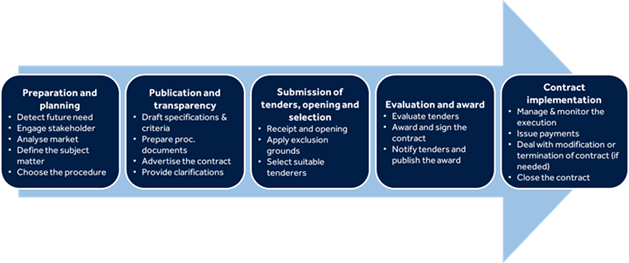6. Public procurement process
Public procurement process
Public procurement is the purchase by governments or public entities of a country of goods and services. In 2014, the European Parliament and European Council adopted Directive 2014/24/EU on public procurement, transposed into national law in the EU Member States [1]. This Directive created a more flexible framework for public procurement to use instruments that enable smart, sustainable, and inclusive growth, ensuring the most efficient use of public funds.
The most common public procurement models include:
- Open tender: this is the main tendering procedure. It allows anyone to submit a tender to supply the goods or services required and offers an equal opportunity to any organisation to place a tender. The main requirements are to be open to all interested bidders, advertised at an appropriate level, precise technical specifications, and provide transparent evaluation criteria [2].
- Low-value contract: this occurs when a procurement does not exceed a specific quantity (established usually by each national regulation). Simplified rules apply for this model. In the EU, the tender should be valued between €15,000 and €144,000.
- Negotiated purchase: this occurs when a contracting authority approaches a single supplier based on their track record or previous relationship (also called preferred vendor). The terms of the contract are then negotiated [3] between the two parties directly.
- Accelerated public tender: this is considered an open tender, but with an accelerated timeframe. This model is mainly used in states of urgency [4].
The typical procurement procedure (Figure 3) includes:
 Figure 3 : Typical procurement procedure stages [5] |
|
|---|
Although the typical procurement procedure is also the usual public procurement process, it often does not consider innovative solutions, goods, and services. The digitalisation of healthcare and Digital Health are two areas in which solutions and services are continuously evolving. Thus, specific procurement models should foster the uptake of innovative solutions by healthcare stakeholders. Although the Organisation for Economic Co-operation and Development (OECD) claims procurement and innovation are not fully aligned nowadays, it is recognised that Public Administration is gradually applying strategies to boost innovation [6]. Two different initiatives may foster innovation procurement by Public Administration:
- Pre-Commercial Procurement (PCPs): this is the procurement of research and development services. PCP is used when no current solutions meet payers' requirements, and alternative solutions must be developed [7] [8].
- The benefits of PCP are:
- Developing innovative solutions for the future needs of societies.
- Support innovative companies by granting access to the procurement market.
- Share risks and benefits of the development of the innovative solutions (designing, prototyping, and testing).
- Reduce market fragmentation and cost for public procurers.
- Create high-quality R&D jobs [9]
- Public Procurement of Innovative solutions (PPIs): This is the procurement of innovative solutions that do not exist on a large-scale commercial basis [10]. This initiative is undertaken when there is evidence that early adopters are willing to purchase the innovative solution (see the following table).
![Comparison of PCP (Pre-Commercial Procurement) and PPI (Public Procurement of Innovative) [13]](https://learning.eupati.eu/pluginfile.php/2429/mod_page/content/18/Table2.png)
Table 1: Comparison of PCP (Pre-Commercial Procurement) and PPI (Public Procurement of Innovative) [11]
References
[1] Commission Directive 2014/84/EU on the safety of the toys as regards nickel. 2014. https://eurlex.europa.eu/legal-content/EN/TXT/PDF/?uri=CELEX:32014L0084
[2] Opus Kinetic. 4 Types of Tender and Tendering Processes. Accessed June 24, 2022. Available at: 4 Types of Tender and Tendering Processes - Opus Kinetic
[3] Designing Buildings. Negotiated tendering. Accessed June 24, 2022. https://www.designingbuildings.co.uk/wiki/Negotiated_tendering
[4] Tenders Direct Blog. The new EU Directive on Public Procurement: Accelerated Procedures. Accessed June 24, 2022. https://blog.tendersdirect.co.uk/2014/05/01/the-new-eu-directive-on-public-procurement-accelerated-procedures/
[5] PUBLIC PROCUREMENT GUIDANCE FOR PRACTITIONERS. Published online 2018. doi:10.2776/461701
[6] Organisation for Economic Co-operation and Development. Public procurement. 2022. https://www.oecd.org/gov/public-procurement/
[7] PICSE. Pre-Commercial Procurement (PCP). Accessed June 24, 2022. http://picse.eu/pre-commercial-procurement-pcp
[8] European Commission. Innovation procurement - H2020 Online Manual. Accessed June 24, 2022. https://ec.europa.eu/research/participants/docs/h2020-funding-guide/cross-cutting-issues/innovation-procurement_en.htm
[9] Pre-Commercial Procurement | Shaping Europe’s digital future. Accessed June 3, 2022. https://digital-strategy.ec.europa.eu/en/policies/pre-commercial-procurement
[10] Public Procurement of Innovative solutions | Shaping Europe’s digital future. Accessed June 4, 2022. https://digital-strategy.ec.europa.eu/en/policies/ppi
[11] European Commission. Innovation procurement. Accessed June 24, 2022. https://ec.europa.eu/growth/single-market/public-procurement/strategic-procurement/innovation-procurement_en